#eleanor moore
Explore tagged Tumblr posts
Text
Wanted Character Connection
Eleanor Moore

Sabitha Frey is looking for her younger sister: Eleanor Moore
The youngest child of Lord Lucias Vypern and his lady-wife Lady Lythene, Eleanor is 25, and is the wife of Lord Petyr Moore of The Vale, with whom she shares a seven year old son, Wyl, and a four year old daughter, Zhoe. A talented embroiderer and skilled in many areas of the visual arts, Elinor takes her greatest joy in calligraphy, and shares a deep fondness for poetry with both her older sister, Lady Sabitha, and her husband, Lord Petyr, the latter of whom is said to have won his lady-wife's heart with a particularly well composed ballad.
For the past three years she has also served as a lady-in-waiting to Princess Helaena Targaryen, though only when both attend court, mainly tending to the Princess' correspondence and other secretarial work, both ladies bonded by their ability to share calm, comfortable silences in one another's company, and the close friendship of their respective sons. Around the Court Elinor is remarked to be well-mannered, creative, and gentle, but some have whispered she is also secretive, overly quiet, and dull.
(Suggested Face Claim: Lin Yun)
Eleanor Moore is also wanted by @helaenasdreamfyres
We are a No-Dance!AU and politics, family, and court-drama focused RP. To join, check out our main site or the blog at @asongofgoldenfireandblackblood or join our Discord for ooc plotting and chatting!
Also feel free to DM this blog if you have any additional questions or want to talk about the RP!
Note: Character name, traits, and faceclaim are suggestions and can be reworked to a certain extent if discussed with the current members of the RP!
#eleanor moore#rp partner wanted#rp partner search#rp partner finder#asoiaf rp#house frey#house moore#house vypern#asongofgf&bb
9 notes
·
View notes
Text

Full name: Eleanor Maria Moore
Nicknames: Ellie (by everyone), The Bitch (by herself, Chloe, and Julie), Moore, Erin, The Queen of Terrible Hair (by Leia), The Queen of Debate (by herself), Mija (by Daniela)
Birth Place: Chicago, Illinois
Birthday: October 15, 1979 (age 15)
Occupation: Student
Family: Daniela Ramirez (mother), Timothy Moore (father)
Romances: TBD
Friends: Chloe Müller (best friend), Julie Kumar-Monét (best friend)
Enemies: Leia Forman
First Appearance: That 90s Pilot (flashback), A Teenager’s Guide to Everything (physical appearance)
Last Appearance:
2 notes
·
View notes
Text
A farewell from Lucy Nolan, Bombalurina in Cast 15 of the Oasis of the Seas.





Performance photos taken by Yurina M. Photography.




With Sarah Moore as Jellylorum, Rachael Aust as Demeter, Eleanor Monaghan as Jennyanydots, Yardén Barr as Babygriz, Zoe Hartley as Cassandra, and Regan Jackson as Coricopat.

Happy trails, Lucy!
#CATS Musical#CATS the Musical#CATS RCCL Cast 15#Bombalurina#Lucy Nolan#Babygriz#Yardén Barr#Jellylorum#Sarah Moore#Jennyanydots#Eleanor Monaghan#Cassandra#Zoe Hartley#Demeter#Rachael Aust
33 notes
·
View notes
Text



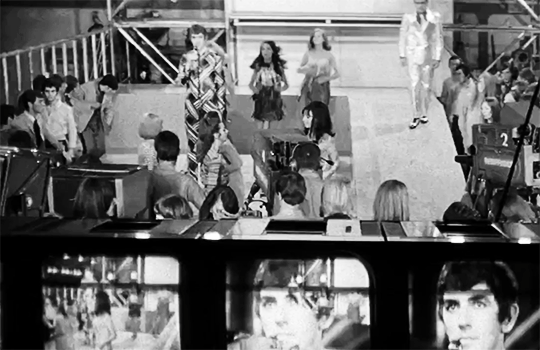


BEDAZZLED (1967) dir. Stanley Donen
#bedazzled#bedazzled 1967#peter cook#dudley moore#eleanor bron#stanley donan#1960s#1960s movies#movie gifs#moviegifs#filmgifs#film gifs#filmedit#film edit#movieedit#movie edit#british film#i made a thing#mine: films
133 notes
·
View notes
Text
instagram story: Aug 10, 2024
#cats oasis of the seas#cats oasis 15#cats rccl 15#rachael aust#demeter (cats)#lucy nolan#bombalurina#abbi sarah moore#jellylorum#eleanor monaghan#jennyanydots#stage cats#see the queue on a sunflower
33 notes
·
View notes
Text
Walden BACC

As the moment everyone waited for approached, the whole group gathered around to witness Lucas blow out the candles and officially become a teen.
Hannah *whispering*: "Rowan, why is your cousin naked?"
Rowan: "Louis! Put some clothes on, c'mon dude, it's a kid's party!"
Louis: "Sorry, I was in the hot tub and when I got out, I couldn't find my clothes anywhere!"
Lucas smirked under his breath.

It was time.

Time to get this over with.

Although...perhaps getting older wasn't all bad. He suddenly felt like he had a better idea of who he was and what he planned to do with his life.

#sims2#the sims 2#ts2#sims 2#sims 2 bacc#bacc: walden#eleanor calhoun#julius merridew#imogen calhoun#lucas merridew#fiona merridew#rowan merridew#rose moore#hannah donnelly#these ended up posted out of sequence#but I feel the story flows better this way#abby shepard
32 notes
·
View notes
Text




:D
21 notes
·
View notes
Text
Emily - From First To Last 【SynthV Cover】
Short cover. Apps: Synthesizer V (Voicebank: Solaria) | Ableton Live
#synthesizer v#synthv#vocal synth#kasane teto#solaria#eleanor forte#gumi megpoid#anri#vocaloid#utau#emily#from first to last#skrillex#sonny moore#ableton#lofi and chill#lofi aesthetic#lofi beats#lofi#chillwave#synthwave#2000s emo#emo scene#emocore#emo aesthetic#2000s nostalgia#2000 emo#2010 emo#cover song#SoundCloud
9 notes
·
View notes
Text

Dudley Moore and Eleanor Bron, 1968
15 notes
·
View notes
Text

Bunny character sheet. 🐰
#i keep forgetting to post my art here lol#oc: Eleanor Bunny Moore#titanic#titanic 1997#one day i'll come up with a name for it but until then#titanic fiction project#lizzy sometimes arts
6 notes
·
View notes
Text
George Moore
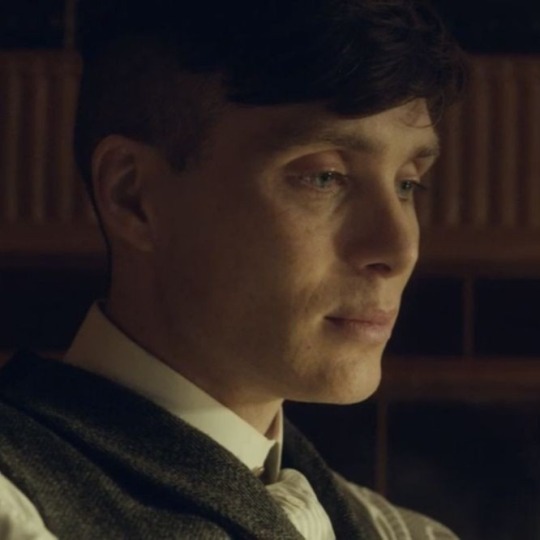
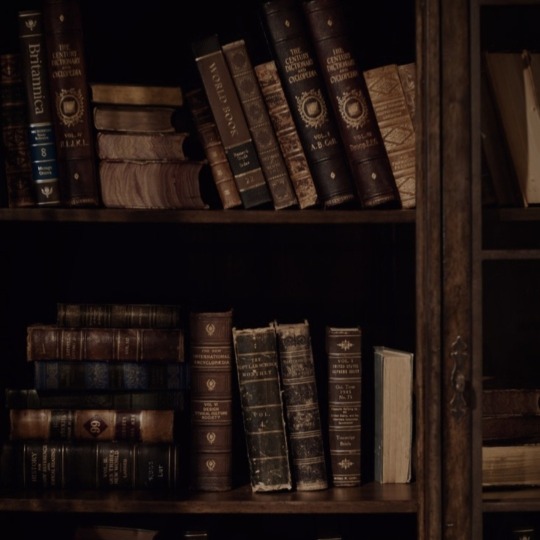


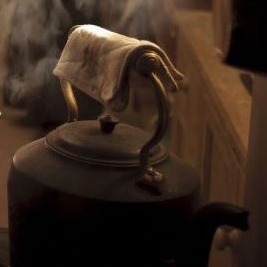




Eleanor Rigby died in the church and was buried along with her name
Nobody came
Father McKenzie wiping the dirt from his hands as he walks from the grave
No one was saved
All the lonely people
Where do they all come from?
All the lonely people
Where do they all belong?
-Eleanor Rigby, The Beatles
George Moore has never been the life of the party. Has never wanted to be, either. He is a man who delights most in a book and a quiet moment with those he loves, the number of which is cursed to be few and far between for as long as he lives, from early childhood at the orphanages to three decades later. He is a man who is not just acquaintances with loneliness, but best friends with being alone.
Janine Mayweather, in the other hand? She is not a wallflower. She is as far from it as can be. She shines from across the room. Her smile makes you feel like the sun is shining on you.
But most of all, she’s smart. Witty. Funny as can be. She doesn’t have the tact yet that she will develop later in life, and that turns off a lot of the guys her age, but to George, it’s like a sun falling on his tight, closed-off petals. He is a flower that turns towards her directness and intelligence.
George knows what he means to her. He knows that she considers him an ally in her fight against the world. He knows that she knows what she can get from him and he from her, and that she sees that as a bargain worth making.
Some might be offended by that definition of love.
But George Moore grew up poor. Alone. He valued his solitude, but he values his girlfriend and her defense of his interests and her warm hugs more. He values the way that she completes him, the way she pulls him into shared friendships with townies and farmers alike, the way she makes herself at home in any crowd.
When George is standing by Janine Mayweather’s side, he isn’t alone. He is welcomed. Valued. And that means something to him.
-Kenna Jenkins, no one else was in the room where it happened
(In honor of me reading his chapter on ao3/the song associated.)
@henrythepug @flower-crowned-lady @neutral-wizard
#burn the house down#kenna jenkins#janine moore#george moore#annette moore#listen my introverted autistic ass relates HARD#he is my guy#my understanding boy#i knew his death was coming from the book but JESUS with the fic#and i listened to the suggested version of Eleanor Rigby#and RUDE#lyrics#aesthetic#eleanor rigby#the beatles
7 notes
·
View notes
Text

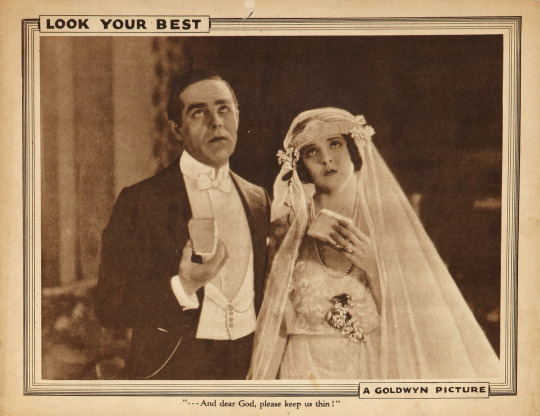

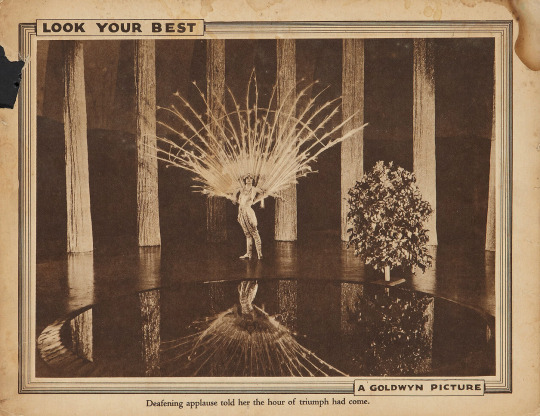
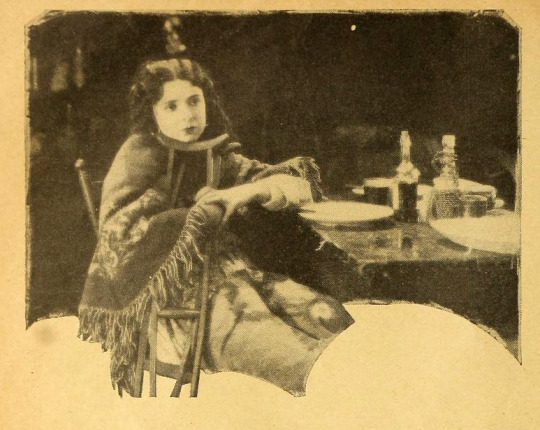
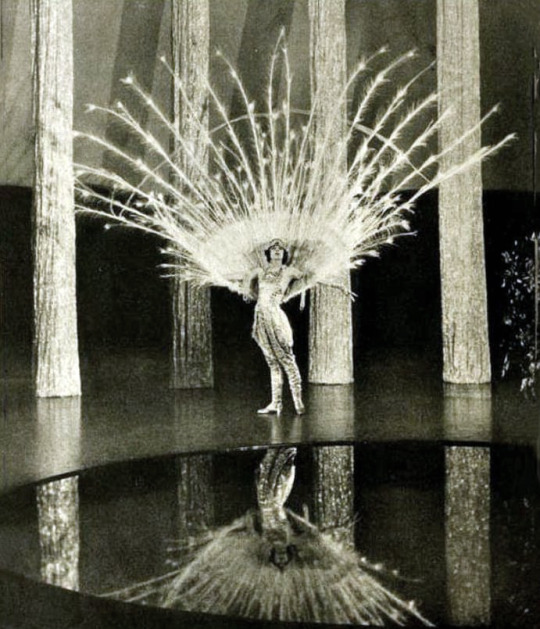



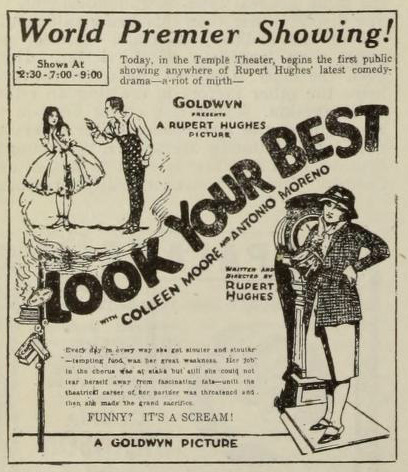
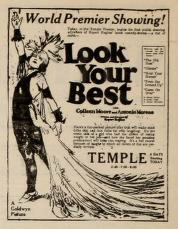
Lost, but Not Forgotten: Look Your Best (1923)
[alternate title: The Bitterness of Sweets]
Direction: Rupert Hughes
Scenario: Rupert Hughes
Camera: Norbert Brodin
Choreography: Ruth St. Denis
Studio: Goldwyn
Performers: Colleen Moore, Antonio Moreno, Earl Metcalfe, Martha Mattox, William Orlamond, Orpha Alba, Francis McDonald, Eleanor Boardman (in a bit role)
Premiere: 18 February 1923, Temple Theatre, Detroit, MI
Status: presumed entirely lost
CW: Dieting / Weight Loss
Synopsis (synthesized from magazine summaries of the plot):
On the streets of New York’s Little Italy, Perla Quaranta* (Moore) dances to the music of her father’s (Orlamond) barrel organ. Unfortunately, Perla’s mother (Alba) has a tendency to grab whatever is at hand for use as a projectile in the midst of arguments with Perla’s father. After one particularly raucous fight, her parents are arrested and sentenced to 30 days. Fortunately for Perla, the owner of a dance troupe, Carlo Bruni (Moreno) scouted her dancing on the streets and hires her to replace a recently fired dancer. The previous girl in Bruni’s “Butterfly Act” was let go after gaining too much weight to do the wirework demanded by the routine. Perla’s privation-induced petiteness is desirable for the role.
Bruni’s struggle with his weight has also apparently gotten in the way of his own work as a dancer. Perla takes well to the role and is a success in the act, which features a number of chorus girls dressed as butterflies flitting across the stage by wire. The stagehand, Krug (Metcalfe), takes a liking to Perla and takes her out regularly as the troupe goes on tour. The now gainfully-employed and avidly-courted Perla has access to all the sweets her heart desires and, in a repeat of her predecessor’s difficulties, she begins to put on pounds. Krug makes an advance on Perla, which she rebuffs. In his bitterness, Krug files Perla’s wires, assuming Bruni will blame the broken wires on her weight and fire her. During the next performance, Perla plummets to the stage and is injured.
Bruni suspects Krug of tampering with the wires, and thrashes him. Bruni is arrested and also given 30 days. While Perla recovers in the hospital, another suitor appears in the form of a baker, Cabotto (McDonald), who buoys her spirits by describing all the different delectations he serves. Meanwhile, behind bars, Bruni envisions a new ballet for the troupe with Perla in a starring role.
When Bruni is freed and Perla is recovered, they reunite and commit to dieting and to each other, via marriage. The new act depicts Perla as a white peacock killed by the hunter, played by Bruni, and mourned by an array of forest nymphs.
(At some point before the final dance number, Perla is reunited with her parents, but, from the synopses, I’m not sure of the order of events.)
* or Quaranti or Moroni based on various reviews
As a side note that I cover more in the annotations below: this plot doesn’t make much sense without a heavy dose of satire, right? The reviews didn’t leave me with a clear idea on whether the film lampoons diet culture or not and, unfortunately for us, unless somebody (maybe some sharp Michigander) makes a lucky discovery, we can’t find out for ourselves!
Transcribed sources & annotations below:
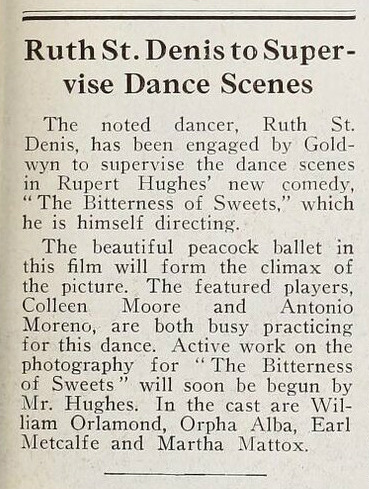
Motion Picture News, April 1922
Ruth St. Denis to Supervise Dance Scenes
The noted dancer, Ruth St. Denis, has been engaged by Goldwyn to supervise the dance scenes in Rupert Hughes’ new comedy, “The Bitterness of Sweets,” which he is himself directing.
The beautiful peacock ballet in this film will form the climax of the picture. The featured players, Colleen Moore and Antonio Moreno, are both busy practicing for this dance. Active work on the photography for “The Bitterness of Sweets” will soon be begun by Mr. Hughes. In the cast are William Orlamond, Orpha Alba, Earl Metcalfe and Martha Mattox.
—
Note: “The Bitterness of Sweets” was the working title of “Look Your Best.”
I hadn’t heard of Ruth St. Denis before now, but seeing what an important role she had in the creation of Modern Dance in America—and that she was a teacher of both Martha Graham and Louise Brooks—it’s an insult to injury that this film appears to be lost. I’m not even sure how many films St. Denis worked on! Many of the reviews below cite the dance numbers as a true highlight of the film too.
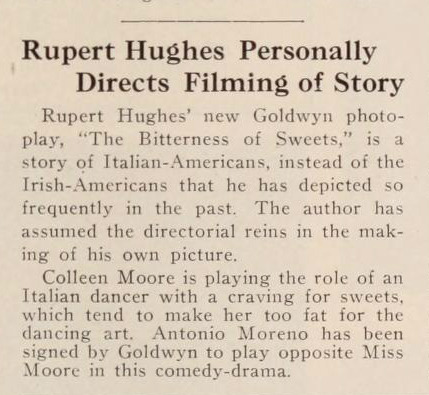
Exhibitor’s Herald, 8 April 1922
Rupert Hughes Personally Directs Filming of Story
Rupert Hughes’ new Goldwyn photoplay “The Bitterness of Sweets,” is a story of Italian-Americans, instead of the Irish-Americans that he has depicted so frequently in the past. The author has assumed the directorial reins in the making of his own picture.
Colleen Moore is playing the role of an Italian dancer with a craving for sweets, which tend to make her too fat for the dancing art. Antonio Moreno has been signed to Goldwyn to play opposite Miss Moore in this comedy-drama.
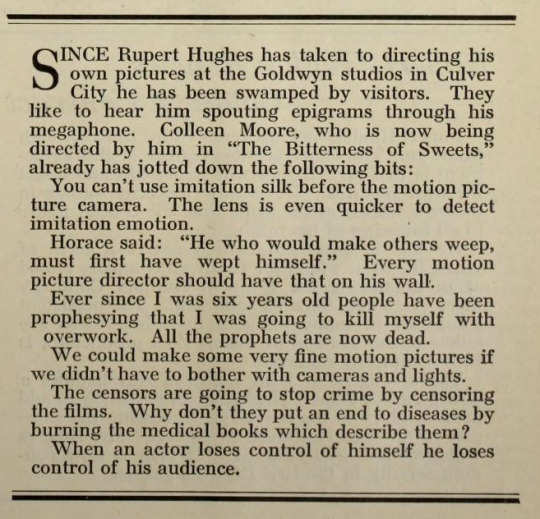
Moving Picture World, 13 May 1922
SINCE Rupert Hughes has taken to directing his own pictures at the Goldwyn studios in Culver City he has been swamped by visitors. They like to hear him spouting epigrams through his megaphone. Colleen Moore, who is now being directed by him in “The Bitterness of Sweets,“ already has jotted down the following bits:
You can’t use imitation silk before the motion picture camera. The lens is even quicker to detect imitation emotion.
Horace said: “He who would make others weep, must first have wept himself.” Every motion picture director should have that on his wall.
Ever since I was six years old people have been prophesying that I was going to kill myself with overwork. All the prophets are now dead.
We could make some very fine motion pictures if we didn’t have to bother with cameras and lights.
The censors are going to stop crime by censoring the films. Why don’t they put an end to diseases by burning the medical books which describe them?
When an actor loses control of himself he loses control of his audience.
—
Note: the timeline for the production to release of this movie is really something. They commenced filming somewhere around the end of April/early May 1922, but it wasn’t released until late February of 1923.
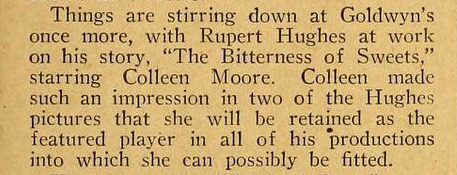
Motion Picture Magazine, June 1922
On the Camera Coast
[excerpt]
Things are stirring down at Goldwyn’s once more, with Rupert Hughes at work on his own story, “The Bitterness of Sweets,” Colleen Moore. Colleen made such an impression in two of the Hughes pictures that she will be retained as the featured player in all of his productions into which she can possibly be fitted.
—
Note: This doesn’t appear to have come to fruition?
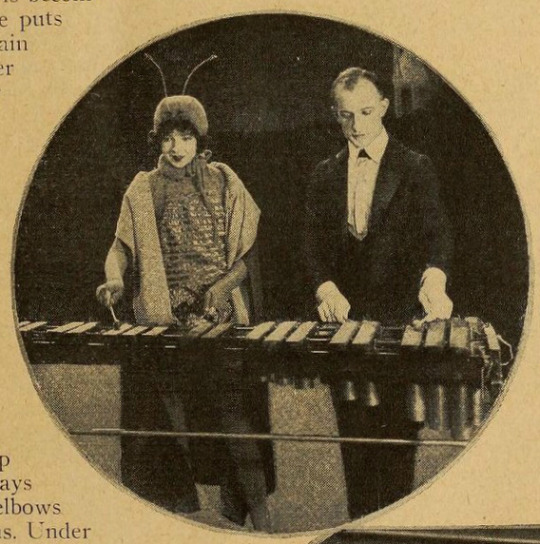
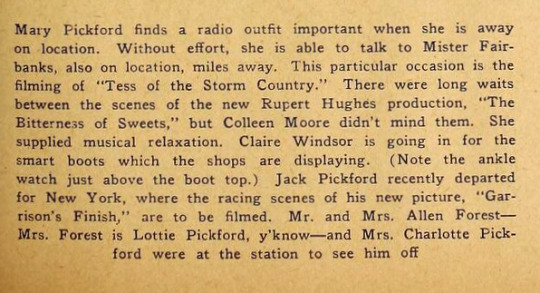
Motion Picture Magazine, September 1922
…There were long waits between the scenes of the new Rupert Hughes production “The Bitterness of Sweets,” but Colleen Moore didn’t mind them. She provided musical relaxation…

Exhibitor’s Trade Review, October 1922
Colleen Moore Sets New Record
Will Be Featured by Five Different Distributing Companies Within Space of Two Months
A record unique in the annals of the motion picture business is being set this fall by Colleen Moore, beautiful and talented young star. Exhibitors who stand by one or another distributing company and who have therefore not had the opportunity to play any of these pictures in which Miss Moore has been featured will note with interest that no less than five distributing companies will offer productions in which she is featured during the coming fall months.
First National will shortly present “Slippy McGee,” the Oliver Morosco production of Marie Conway Oemler’s well known story, in which Miss Moore plays the leading feminine role.
Goldwyn will soon release two pictures in which Miss Moore will be featured. The first will be Rupert Hughes’ production of “The Bitterness of Sweets,” which was personally directed by the author. Tony Moreno plays opposite Miss Moore in this production. The second Goldwyn feature will be “Broken Chains,” the widely advertised $10,000 prize story which was transferred to the screen under the capable direction of Allen Holubar.
Hodkinson has already delivered to its exchanges the prints of “Affinities,” a picturization of the Mary Roberts Rhinehart story of the same name. This is a Ward Lascelle production in which Miss Moore is starred.
Universal announces that Miss Moore will soon be seen in the featured feminine role in “Forsaking All Others,” a drama which has just been completed under the direction of Emile Chautard. It will be released as a Jewel special.
Rounding out the quintet, Vitagraph is now nearing completion of a picturization of the famous old stage success “The Ninety and Nine,” with Miss Moore in the featured role and directed by Dave Smith. This production will also be a special release.
—
Note: Slippy McGee (premiered June 1923, status unknown) , Broken Chains (premiered December 1922, extant), Affinities (premiered October 1922, status unknown), Forsaking All Others (premiered December 1922, status unknown), The Ninety and Nine (premiered December 1922, only 10 minutes of the film survive (available on Undercrank Productions’ Accidentally Preserved Vol. 4))
This item implies that LYB was intended for release in the fall/winter of 1922, though an exact date isn’t given.
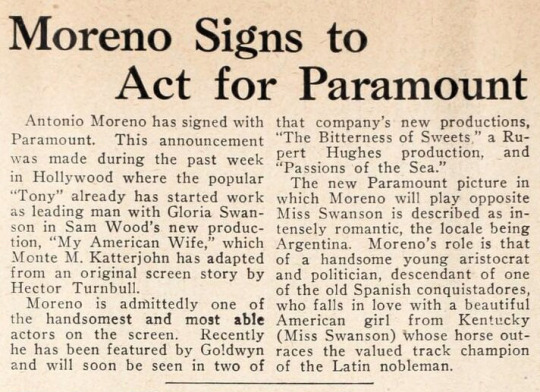
Moving Picture World, October 1922
Moreno Signs to Act for Paramount
Antonio Moreno has signed with Paramount. This announcement was made during the past week in Hollywood where the popular “Tony” already has started work as leading man with Gloria Swanson in Sam Wood’s new production, “My American Wife,” which Monte M. Katterjohn has adapted from an original screen story by Hector Turnbull.
Moreno is admittedly one of the handsomest and most able actors on the screen. Recently he has been featured by Goldwyn and will soon be seen in two of that company’s new productions, “The Bitterness of Sweets,” a Rupert Hughes production, and “Passions of the Sea.”
The new Paramount picture in which Moreno will play opposite Miss Swanson is described as intensely romantic, the locale being Argentina. Moreno’s role is that of a handsome young aristocrat and politician, descendant of one of the old Spanish conquistadores, who falls in love with a beautiful American girl from Kentucky (Miss Swanson) whose horse out-races the valued track champion of the Latin nobleman.
—
Note: My American Wife (premiered February 1923, status unknown), Passions of the Sea (premiered in February 1923 as Lost and Found on a South Sea Island, extant)

Motion Picture News, February 1923
Pre-release Reviews of Features
“Look Your Best ”
Goldwyn—Six Reels
(Reviewed by Charles Larkin)
TO EAT, to grow fat, to spoil one’s career. To starve, to keep thin, to become a great artiste. That is the choice given Perla Quaranta, a little Italian girl portrayed by Colleen Moore, who is one day noticed dancing in the streets by Carlo Bruni, manager of a small theatrical troupe, and who is given the place of the chorus lady who has fallen to the temptation of too many sweets, with the result that the perfect 36 has developed into an imperfect 40 or so. Perla is a success in the act but as she goes from town to town, accepting invitations from Krug, a stage hand, to dine, she also begins to take on weight. Krug, maddened at her coldness, when he makes advances, weakens the wire that holds Perla aloft in a butterfly stunt and she falls to the stage. Krug thought he could tell the folks Perla’s avoirdupois was to blame. Bruni, however, knocks Krug for a goal and gets thirty days for his gallantry. However, thirty days pass soon in some jails, and Bruni is soon out and starting a new ballet with Perla.
And so it goes. It isn’t much of a picture and there is a fight between Perla’s mother and father which takes up much footage and could be eliminated much to the improvement of the story. In fact, the dropping of these two characters throughout would not be missed in the least. To see a boisterous hurdy gurdy grinder jump from jail into a theatre box in a dress suit is not being done these days. There is a very artistic ballet scene toward the end of this picture.
This is not the best thing Rupert Hughes has written and adapted for the screen. Neither is it his best directed picture. Of course, one can’t expect any company to continue releasing masterpieces all the time. We can’t have a “Christian” every day. There have got to be some program pictures once in a while. This is one. It will serve its purpose and is suitable for second-class downtown houses, and there may be many who may find much humor in its fat and thin theme—especially those who are fighting either evil.
The Cast
Perla Quaranta…Colleen Moore
Carlo Bruni…Antonio Moreno
Pietro…William Orlamond
Nella…Orpha Alba
Krug…Earl Metcalfe
Mrs. Blitz…Martha Mattox
Alberto Cabotto…Francis McDonald
By Rupert Hughes. Directed by Rupert Hughes. Scenario by Rupert Hughes. Photographed by Norbert Brodin.
The Story—Deals with the horror in which some folks hold plain good old fat. A chorus girl having attained this terrible state, is fired and Perla, a daughter of Little Italy, is given her place in Bruni’s “Butterfly Act.” Perla made good and went on the road with the show. She also went out to dine with one Krug and began to put on flesh. Krug, a disappointed suitor, filed one of the wires which held Perla aloft in the butterfly stuff. During the act she crashed to the stage. Bruni beats up Krug and gets 30 days. Emerging from jail he starts a new ballet, engages Perla and the two rise to fame.
Classification—One of Rupert Hughes’ problem plays—the problem of keeping thin.
Production Highlights—Colleen Moore’s characterization of the role of the little Italian girl. The crashing of Perla to the stage floor as a result of the villain weakening the wire which holds her.
Exploitation Angles—The title. The eat and grow thin or fat as you will theme offers a chance to tie up with the health department, Y. W. C. A. women’s walking clubs, etc.
—
Note: “Deals with the horror in which some folks hold plain good old fat.” There’s only so much I can assume about the movie’s treatment of weight gain and dieting, as it is lost, but from all the synopses I read, I gotta say as a plot device it doesn’t seem to make much sense? Like, obviously in the performing arts, the expectation to stay at one precise size is stricter than in other fields, but it seems like there is no real logic at play here? I’m glad this reviewer points out that it comes off as Rupert Hughes just hating fat people. Another reviewer mentions a noteworthy lack of satire in the film, and, from the details in the synopses, it seems like this plot would only really make sense if it were a satire or critique on diet culture.
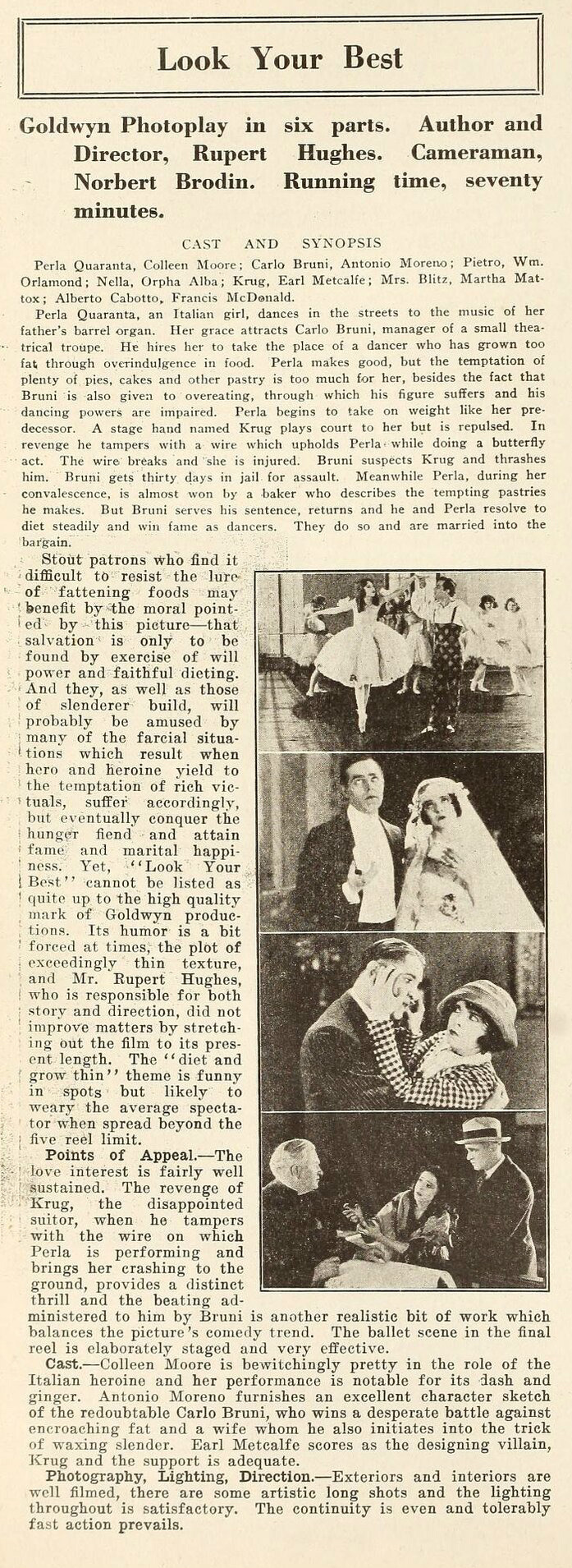
Exhibitor’s Trade Review, February 1923
Look Your Best
Goldwyn Photoplay in six parts. Author and Director, Rupert Hughes. Cameraman, Norbert Brodin. Running time, seventy minutes.
CAST AND SYNOPSIS
Perla Quaranta, Colleen Moore; Carlo Bruni, Antonio Moreno; Pietro, Wm. Orlamond; Nella, Orpha Alba; Krug, Earl Metcalfe; Mrs. Blitz, Martha Mattox; Alberto Cabotto, Francis McDonald.
Perla Quaranta, an Italian girl, dances in the streets to the music of her father’s barrel organ. Her grace attracts Carlo Bruni, manager of a small theatrical troupe. He hires her to take the place of a dancer who has grown too fat through overindulgence in food. Perla makes good, but the temptation of plenty of pies, cakes and other pastry is too much for her, besides the fact that Bruni is also given to overeating, through which his figure suffers and his dancing powers are impaired. Perla begins to take on weight like her predecessor. A stage hand named Krug plays court to her but is repulsed. In revenge he tampers with a wire which upholds Perla while doing a butterfly act. The wire breaks and she is injured. Bruni suspects Krug and thrashes him. Bruni gets thirty days in jail for assault. Meanwhile Perla, during her convalescence, is almost won by a baker who describes the tempting pastries he makes. But Bruni serves his sentence, returns and he and Perla resolve to diet steadily and win fame as dancers. They do so and are married into the bargain.
Stout patrons who find it difficult to resist the lure of fattening foods may benefit by the moral pointed by this picture—that salvation is only to be found by exercise of will power and faithful dieting. And they, as well as those of slenderer build, will probably be amused by many of the farcical situations which result when hero and heroine yield to the temptation of rich victuals, suffer accordingly, but eventually conquer the hunger fiend and attain fame and marital happiness. Yet, “Look Your Best” cannot be listed as quite up to the high quality mark of Goldwyn productions. Its humor is a bit forced at times, the plot of exceedingly thin texture, and Mr. Rupert Hughes, who is responsible for both story and direction, did not improve matters by stretching out the film to its present length. The “diet and grow thin” theme is funny in spots but likely to weary the average spectator when spread beyond the five reel limit.
Points of Appeal.—The love interest is fairly well sustained. The revenge of Krug, the disappointed suitor, when he tampers with the wire on which Perla is performing and brings her crashing to the ground, provides a distinct thrill and the beating administered to him by Bruni is another realistic bit of work which balances the picture’s comedy trend. The ballet scene in the final reel is elaborately staged and very effective.
Cast.—Colleen Moore is bewitchingly pretty in the role of the Italian heroine and her performance is notable for its dash and ginger. Antonio Moreno furnishes an excellent character sketch of the redoubtable Carlo Bruni, who wins a desperate battle against encroaching fat and a wife whom he also initiates into the trick of waxing slender. Earl Metcalfe scores as the designing villain, Krug and the support is adequate.
Photography, Lighting, Direction.—Exteriors and interiors are well filmed, there are some artistic long shots and the lighting throughout is satisfactory. The continuity is even and tolerably fast action prevails.

Motion Picture Magazine, March 1923
Comments on Numerous Productions
LOOK YOUR BEST — GOLDWYN
Rupert Hughes gets off on a different tack in this, his latest expression. He makes a plea to be on the look-out for adipose tissue as a destroyer of beauty. And he argues his point thru a weirdly melodramatic story of a chorus girl who develops obesity and is discharged as a result. A slender girl is taken on and proves a sensation. Comes then a bit of Italian jealousy when a disappointed lover files the wires in the ballet number, causing the little “butterfly” to crash to the stage. Mr. Hughes’s satiric vein is missing here. In fact you wouldn’t recognize his style here at all. It’s breath-taking, now and then, but many of the scenes are clumsily executed and the characters are not deftly drawn. Colleen Moore succeeds in being genuine, as usual, in her portrayal of the ballet girl. And Tony Moreno is a satisfactory lover—of the hot Italian school.
---
Note: Interesting point here that there is a lack of “Hughes’ satiric vein.” I haven’t seen much of his work as of yet, so I don’t know what sort of satire would be typical of Hughes’ work. However the plot details laid out across various reviews and synopses don’t just strain credibility they tear it to shreds, UNLESS the whole thing was a satire on diet culture, but as far as I can tell, it’s just straight-up fatphobia. A shame, for sure, because this sort of story told as a lampooning of diet culture honestly sounds pretty darn entertaining.

Motion Picture Magazine, March 1923
Rupert Hughes went out to the Palm Springs on the edge of the desert to make the opening scenes of the film version of his novel “Souls for Sale.” It suddenly began to rain in the way rain comes down in the desert and the company was stuck there in idleness for a week. Claire Windsor, Richard Dix, Frank Mayo, Lew Cody and other well known actors will be in the cast. It has always been supposed that Maj. Hughes drew the heroine of his story to a certain extent from Claire Windsor, altho, of course, with liberal modifications. It almost went without saying that she would have the part when the story was screened.
The name of Maj, Hughes’ story, “The Bitterness of Sweets,” has been changed to “Look Your Best.” This was the picture in which Colleen Moore appeared as a dancer.
—
Note: Considering the extended timeline between the production and release of Look Your Best, the production of Souls for Sale (premiered March 1923, extant) commenced directly after LYB wrapped. So, Hughes’ second and third feature for Goldwyn premiered within a month of each other, with Souls for Sale being a larger production and more heavily marketed. I’m wondering if holding off on the release of Look Your Best was due to a lack of faith in the final product and a desire not to prematurely tarnish the rep of a writer/director that Goldwyn had just signed on for a lot of pictures? That is, releasing it close to Souls for Sale seems like a smart call because Souls for Sale’s quality and higher box-office potential would likely minimize any doubts about Hughes’ abilities that might arise if his second film for Goldwyn was as underwhelming as reviewers and exhibitors portray it. Alternatively or additionally, maybe the studio deemed LYB a “programmer” after production wrapped and was simply waiting for a better time on their release schedule.

The Film Daily, 30 March 1923
Putting It Over
Here is how a brother exhibitor put his show over. Send along your ideas. Let the other fellow know how you cleaned up.
Fashion Pageant Staged
Toledo—Eddie Carrier, Goldwynner put over “Look Your Best” at the Pantheon exploitation campaign.
The outstanding feature was the presentation of a fashion pageant, which was staged in co-operation with the Thompson Hudson Co. department store. A number of manikins were brought to Toledo by Carrier. A runway was constructed out into the audience along which the beauties promenaded adorned with the seasons latest fads and fancies. The runway had special illumination and the spectacle was said the most elaborate ever staged.
—
Note: There are a number of news items about exploitation schemes for the film that tie in with other local businesses, but, humorously, the tie-ins are with department stores and have to do with fashion and cosmetics, when that seemingly has nothing to do with a movie about vaudeville performers and dieting!
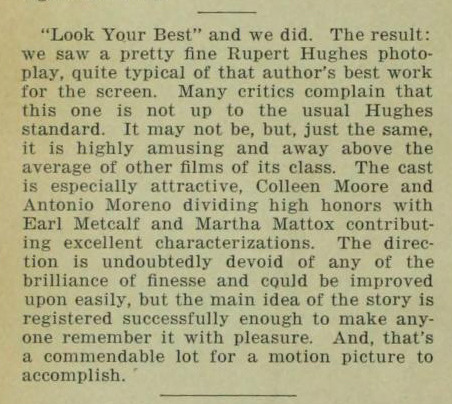
Camera, 30 March 1923
THE SILENT TREND
Composite of Views, Previews, and Reviews of Motion Pictures.
“Look Your Best” and we did. The result: we saw a pretty fine Rupert Hughes photoplay, quite typical of that author’s best work for the screen. Many critics complain that this one is not up to the usual Hughes standard. It may not be, but, just the same, it is highly amusing and away above the average of other films of its class. The cast is especially attractive, Colleen Moore and Antonio Moreno dividing high honors with Earl Metcalf and Martha Mattox contributing excellent characterizations. The direction is undoubtedly devoid of any of the brilliance of finesse and could be improved upon easily, but the main idea of the story is registered successfully enough to make anyone remember it with pleasure. And, that’s a commendable lot for a motion picture to accomplish.

Motion Picture News, April 1923
Elaborate Style Show Put Over with “Look Your Best”
Toledo, Ohio.—The management of the Pantheon theatre, in conjunction with Goldwynner Eddie Carrier, put on an elaborate exploitation campaign on “Look Your Best,” the outstanding feature of which was a fashion pageant staged in co-operation with the Thompson-Hudson Company, a leading department store.
A bevy of beautiful mannequins was assembled, and a runway was built far out into the audience, on which they promenaded with the latest fashion creations. Special lighting and scenic effects were used and a musical score was provided for the occasion. The department store co-operated with a double-page ad, seven full window displays and 2,500 letters to its customers.
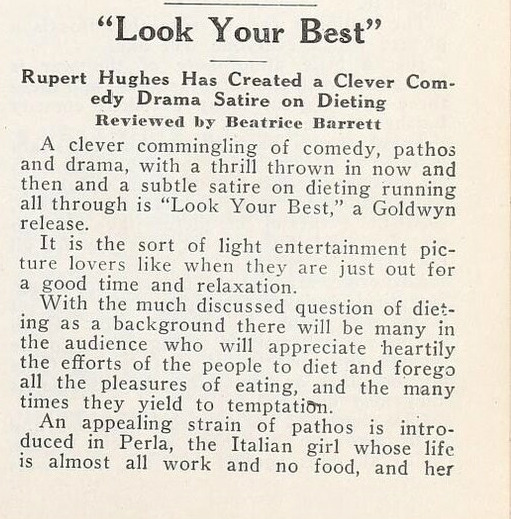

Moving Picture World, April 1923
“Look Your Best”
Rupert Hughes Has Created a Clever Comedy Drama Satire on Dieting
Reviewed by Beatrice Barrett
A clever commingling of comedy, pathos and drama, with a thrill thrown in now and then and a subtle satire on dieting running all through is “Look Your Best,” a Goldwyn release.
It is the sort of light entertainment picture lovers like when they are just out for a good time and relaxation.
With the much discussed question of dieting as a background there will be many in the audience who will appreciate heartily the efforts of the people to diet and forego all the pleasures of eating, and the many times they yield to temptation.
An appealing strain of pathos is introduced in Perla, the Italian girl whose life is almost all work and no food, and her childish pleasure in her first nice clothes. Colleen Moore does well this wistful role. There is always a fascination about life back of the curtain and there are many scenes here of the rehearsals and scenes in the dressing rooms that will attract.
Very beautiful are the scenes of the Butterfly Girls with great gauze wings executing their dance and then suspended on wires flying through the air. The stage sets and the dance which Antonio Moreno and Colleen Moore do at the end of the picture is also very artistic and gives an air of a big production to what at times seems to be simply a comedy.
Rupert Hughes worked up through many laughs to the big thrill of the cut wire and has handled very well these scenes with the girl flying through the air coming right toward the camera—and all the while the audience knows the wire is going to break—and it does and there is a fall that will give them a shudder.
The plot is a gossamer one, and simply a thread which lightly holds together the events of the story—but in a picture of this character you don’t expect much plot. The audience will be chuckling and enjoying each new incident as it comes along.
Cast
Perla Moroni…Colleen Moore
Carlo Bruni…Antonio Moreno
Pietri…William Orlamond
Nella…Orpha Alba
Krug…Earl Metcalf
Mrs. Blitz…Martha Maddox
Alberta Cobatto…Francis MacDonald
Written and directed by Rupert Hughes.
6 reels.
Story
Perla, a half starved Italian girl, is engaged by Bruni to be one of his butterfly dancers because she is so thin. Krug, the wireman, becomes infatuated with Perla. She begins to get fat, and when she tires of Krug’s attentions he files the wire on which she hangs as a butterfly so Bruni will think she is too fat for the part and discharge her. Bruni used to be a beautiful dancer but through love of food grew too fat and could no longer dance. He and Perla both start to diet. He composes a beautiful dance for them and they are a great success. The story ends with their wedding—and the two still dieting.
—
Note: Now, this reviewer thinks the film is a satire of dieting?

Exhibitor’s Herald, 7 April 1923
COLLEEN MOORE IN
LOOK YOUR BEST
(GOLDWYN)
A cheerful little story of an Italian girl who becomes an actress and then has a hard time keeping her job because of overeating. An interesting picture of backstage life, and although not one of Rupert Hughes greatest plays, is quite satisfying. Author: Rupert Hughes; Continuity: Rupert Hughes; Director: Rupert Hughes. Length six reels.
There is just a little over an hour’s pleasant diversion in this latest Rupert Hughes-Goldwyn production. It is a quaint mixture of pathos, humor and drama. The humor borders on the slapstick, while the melodrama is the good old-fashioned “s-death” kind. However, there is the ever appealing Colleen Moore in it, as the interesting little toe dancer, and Antonio Moreno as a ballet master. Add to these William Orlamond, as Pietro; Orpha Alba, as Bella, his wife; Earl Matcalfe, as Krug, the villain; Martha Mattox, ad Mrs. Blitz; and Francis McDonald, as Cabotto, a suitor for Perla’s hand, and you have a cast capable of good things.
At the State-Lake theater, Chicago, where the picture followed the trained seals, it got a few laughs and held the attention of a vaudeville-loving audience. And you’ll certainly enjoy Colleen Moore more and more.
The story concerns Perla, a little New York girl of Italian parentage who goes into Bruni’s butterfly dance act in vaudeville and finds she must deny herself the sweets she loves in order to remain slender. The man who manipulates the wires, failing to win her love, plots to get her discharged for putting on too much flesh. He cuts the wire supporting her, but Bruni discovers his treachery and engages him in a fight, which lands both in jail, but on Bruni’s release Perla is waiting to reward him with her hand.

Screen Opinions, June 1923
“LOOK YOUR BEST”— [Class B] 65%
(Especially prepared for screen)
Story:—Romance of Little Italy, a Girl and a Theatrical Manager
VALUE
Photography—Very good—Norbert Brodin.
TYPE OF PICTURE—Entertaining.
Moral Standard—Average.
Story—Good—Comedy-drama—Family.
Stars—Good—Colleen Moore and Antonio Moreno.
Author—Good—Rupert Hughes.
Direction—Good—Rupert Hughes.
Adaptation—Good—Rupert Hughes.
Technique—Good.
Spiritual Influence—Neutral.
CAST
Perla Quaranti…Colleen Moore
Carlo Bruni…Antonio Moreno
Pietro…William Orlamond
Nella…Orpha Alba
Krug…Earl Metcalfe
Mrs. Blitz…Martha Mattox
Alberto Cabotto…Francis McDonald
June 1 to 15, 1923.
Producer—Goldwyn
Footage—6,000 ft.
Distributor—Goldwyn
Our Opinion
MORAL O’THE PICTURE—If You Would Look Well, Mind Your Diet.
Not Particularly Artistic, but Makes Good Entertainment—Stars Do Well
Scenes in Little Italy, in which an Italian organ grinder and his wife are forced to serve a thirty-day sentence in jail following a knife and china shower, are fraught with comedy, and so also is the initiation of Perla, the pretty daughter, into the stage technique of playing butterfly and being hoisted on a wire to flutter her butterfly wings. Colleen Moore is charming in the role of Perla, and one of the notably good performances of the picture is done by Orpha Alba, who plays the role of Nella Quaranti, Perla’s mother, who, between laughter and tears, chastises her husband, Pietro, with the first article that comes to hand, no matter what the substance is, and then makes parting at the jail “such sweet sorrow.” William Orlamond is the type for Pietro, and Antonio Moreno, as Bruni, whose theatrical grace was spoiled by too much eating, is also very good. Earl Metcalfe, as Krug, elected to serve as Perla’s wire hoister, in love with her and reproachful when he failed to obtain kisses in return for the food that made Perla “not as thin as she used to was,” is all that the role requires—he does well. Francis McDonald is the baker joy and jealous lover, and looks and acts the part. The picture contains some attractive stage scenes with the butterfly girls flitting rapidly past the camera, and there is also an elaborately staged classic dance, supposed to take place in the greenwood, in which Colleen Moore is dressed as a white peacock, which is slain by the hunter, Antonio Moreno, and mourned by the wood nymphs. This is really a very enjoyable feature.
STORY OF THE PLAY
Perla Quaranti, a street dancer, finds herself alone when her father and mother are sentenced to thirty days in jail for fighting. She is offered a position by Carlo Bruni, an Italian theatrical manager, whose specialty is a group of butterfly girls. Perla, filling the place of a girl who got too stout to hoist, grasps good fortune by the neck and eats herself stout also on the bounty of one Krug, a wirehoister. Krug plays her false when he realizes that she loves Bruni instead of himself, and takes revenge by cutting the wire so that during the whirl of butterflies Perla falls to the stage and is injured. The story closes happily with Perla and her parents reunited, and Bruni her prospective husband.
PROGRAM COPY—”Look Your Best”—Colleen Moore and Antonio Moreno
Perla Quaranti’s butterfly days ended with a bang when a jealous lover took revenge for lack of kisses. Don’t miss seeing Colleen Moore, Antonio Moreno and an excellent cast in “Look Your Best,” one of the funniest and most original of recent comedies.
—
Note: This is the only review that adds detail about Perla’s parents. Another reviewer complained that the bits with her parents were wholly superfluous. Other reviewers barely mention that they are even in the film!
Moving Picture World, 9 June 1923
Sells First Showing on the Type Argument
The Temple Theatre, Detroit, does not believe in too much splash, even for a world premier, and gets along very nicely with 100 by 3 for Look Your Best, using two cuts and six lines of snappy stuff about the nature of the play to back up the illustrations. Apparently these illustrations are from the plan book, and they have no strong illustrative value, but the upper one suggests the stage story, which this is, and the lower the growing weight of Colleen Moore, which is the essence of the plot. The selling value lies chiefly in the talk, and here this talk is a quiet little chat about the play with no particular stress, just an intimate tip-off on the nature of the play which is more convincing than a many-adjectived oration could possibly be. It is so good that it might have been put into larger type, even at the cost of one of the cuts. And make a note now that Look Your Best is going to make a wonderful peg for hook-up pages and style shows. Combine the two of them by starting early enough to get your plans all properly laid. There are a lot of similar co-operative angles, but these will be the best bets. -P. T. A.-
Poster blurb: Every day in every way she gets stouter and stouter—tempting food was her great weakness. Her job in the chorus was at stake but still she could not tear herself away fascinating fats—until the theatrical career of her partner was threatened and then, she made the grand sacrifice.
FUNNY? IT’S A SCREAM!
— Note: photo of the interior of the now demolished Temple Theatre, a popular vaudeville venue.
---
Exhibitor’s Trade Review, July 1923
SLOGAN BASIS OF MERCHANT TIE-UP
Madison, Wis.—A merchant tie-up on a “Look Your Best” Week was put across by Dr. Wm. E. Beecroft, manager of the Parkway Theatre, and Goldwynner W.D. Nealand, in connection with the screening of “Look Your Best.” Art Kniseley, advertising manager of the Burdick & Murray Department Store, went in heavily with the theatre management on this “Look Your Best” week.
He gave the picture a splendid window display, using the slogan “Look Your Best” as a sales aid for their clothing, millinery, hosiery and toilet articles. In addition to the window display, Mr. Kniseley ran a sixty-eight inch advertisement in both the State Journal and the Capitol Times, tieing up with “Look Your Best.”
---
Moving Picture World, September 1923
Consensus of Published Reviews
Look Your Best
(Colleen Moore—Goldwyn—6 reels)
M. P. W.—A clever commingling of comedy, pathos and drama, with a thrill thrown in now and then and a subtle satire on dieting.
E. H.—Is a cheerful little story of backstage life. It was written and directed by Rupert Hughes, and although not his greatest play, will be found highly diverting as an hour’s entertainment.
N.—It will serve its purpose and is suitable for second-class downtown houses.
T. R.—The “diet and grow thin” theme is funny in spots but likely to weary the average spectator.
---
Picture Play Magazine, October 1923
Keeping Nature’s Gifts
[excerpt]
Colleen Moore’s diet depends upon whether she is putting on flesh for a picture or taking it off. She lived practically on lemon-juice for two weeks, losing ten pounds at the start of “Look Your Best.” For the last scenes she had to regain her avoirdupois, so she went to bed for a week, drank milk-two or three quarts a day and ate cakes and everything.
—
Note: I hate this.
---
Exhibitor’s Herald, 24 November 1923
Goldwyn Cosmopolitan
Look Your Best, with Colleen Moore. —A very good picture that failed to score at all at the box office. I have played ten of these pictures, losing money on eight, breaking even on one, so I really will be glad when they are over with. The advertising matter is my greatest drawback, for I’m a little fellow and can’t afford an artist to make my lobby and have to use their stock stuff, which is bum considering the attractions they represent. Pretty enough, but do not run true with the films. Seven reels.—Hugh G. Martin, American theatre, Columbus, Ga.—General patronage.
Look Your Best, with Colleen Moore and Antonio Moreno.—Two dandy stars wasted in this. Rupert Hughes was unable to convince an audience of movie fans what he was driving at. Lacked interest all the way. Not worth bothering about.—Ben L. Morris, Temple theatre, Bellaire, Ohio.—General patronage.
---
Moving Picture World, December 1923
LOOK YOUR BEST. (6 reels). Star, Colleen Moore. A very ordinary picture that I played on a Saturday night and put in a strong line of fillers and in that way escaped censure. You can play this, but be careful of your accompanying selections and buy it right. Usual advertising brought good attendance. Draw health seekers and tourists. Dave Seymour, Pontiac Theatre Beautiful, Saranac Lake, New York.
LOOK YOUR BEST. (6 reels). Star cast. Nice little comedy-drama. Very light in construction. Seemed to please. Had fair attendance. Draw all classes in town of 1,000. Admission 15-25. Jack Kaplan, Rivoli Theatre (378 seats), South Fallsburg, New York.
---
Best Moving Pictures, 1922-1923
LOOK YOUR BEST. Produced and distributed by Goldwyn. Six reels. Released February 18, 1923. Cast: Colleen Moore and Antonio Moreno. Director, Rupert Hughes. Story of a chorus girl who tried to keep thin.
---
The Educational Screen, February 1924
THE THEATRICAL FIELD
LOOK YOUR BEST (Goldwyn)
Colleen Moore and Antonio Moreno demonstrate the tragic fact that life is very bitter to the lover of sweets when his job depends on his remaining thin. Fair entertainment, making no demands on either actors or audience.
---
Motion Picture Magazine, November 1924
Every Little Bit Helps—to Stardom
By HARRY CARR
[excerpt]
Eleanor Boardman came to the old Goldwyn lot and jumped at once into the top line by a tiny scene in Rupert Hughes’ The Bitterness of Sweets, in which she fainted in a theater box.
—
Note: Given what I noted earlier about the release dates of LYB and Souls for Sale, finding out that a bit role in LYB (here referred to by its working title) led to Eleanor Boardman’s starring role in the latter film is fascinating. Boardman likely filmed her single scene in LYB months before production started on Souls for Sale, which she is the star of. But, because the release of LYB was delayed, Boardman had a bit role and a starring role on screens within a month of each other!
#Look Your Best#The Bitterness of Sweets#lost film#silent comedy#silent era#silent film#silent movies#1920s#1922#1923#Rupert Hughes#Colleen Moore#antonio moreno#eleanor boardman#classic movies#classic film#american film#movie magazine#film magazine#Souls for Sale#ruth st. denis#film history#lost but not forgotten
15 notes
·
View notes
Photo








The Maddison-Danes-Favian Family Tree
Maternal Grandmother
Name: Melissa Eleanor Danes Ellie Marie Maddison
Face Claim: Julienne Moore
Maternal Grandfather [Deceased]
Name: Edward Danes
Face Claim: Liam Neeson
Step-Grandmother
Name: Lilith Shane Maddison
Face Claim: Michelle Gomez
Parental Grandmother
Name: Lilibet Constantine Daphne Favian
Face Claim: Jamie Lee Curtis
Mother
Name: Calliope Favian
Face Claim: Amy Adams
Father
Name: Ethan Favian
Face Claim: Robert Downey Jr
Twin Brother
Name: Anthony Eleanor Favian
Face Claim: K.J. Apa
Maternal Aunt
Name: Juliet Favian
Face Claim: Natalie Dormer
Uncle [Deceased]
Name: Daniel Favian
Face Claim: Jeffery Dean Morgan
Cousin’s Father
Name: Jackson Kineth Reiley
Face Claim: Ian Bohen
Cousin; Nica
Name: Dominica Lillie Favian
Face Claim: Madelaine Petsch
Tumblr: @gingerly-artful
Maternal Aunt
Name: Whitney Danes
Face Claim: Isla Fisher
#oc: marilyn edward favian#fc: holland roden#oc: ellie marie maddison#fc: julienne moore#oc: edward danes#fc: liam neeson#oc: lilith shane maddison#fc: michelle gomez#oc: lilibet constantine daphne favian#fc: jamie lee curtis#oc: calliope favian#fc: amy adams#oc: ethan favian#fc: robert downey jr#oc: anthony eleanor favian#fc: k.j. apa#oc: juliet favian#fc: natalie dormer#oc: daniel favian#fc: jeffery dean morgan#oc: jackson kineth reiley#fc: ian bohen#oc: dominica lillie favian#fc: madelaine petsch#oc: whitney danes#fc: isla fisher
6 notes
·
View notes
Text
The traditional of makeup swapping after closing in the Oasis of the Seas continues with Cast 15.

Featuring Noah Lindquist as Sillabub, Kane Verrall as Mistoffelees, Jared Johnson (?) as Old Deuteronomy, Peyton Davis as Plato, Connor Dyer as Munkustrap, Billy Roger (?) as Skimbleshanks, Eleanor Monaghan (?) as Bombalurina, Sarah Moore as Mungojerrie, Nick Woodford as Coricopat, and Rachael Aust as Cassandra.


Sarah Moore as Mungojerrie, with a makeup reference for both Notorious Cats.


Zoe Hartley as Victoria, Rachael Aust as Cassandra, and Gina Gagliano as Demeter.


Dani Ciaramitaro as Jellylorum and Josie Harbertson as Gus get spirited.



Peter James Lake as Tantomile, Connor Dyer as Munkustrap, Noah Lindquist as Sillabub, and Kane Verrall as Mistoffelees.
25 September 2024.
#CATS Musical#CATS the Musical#CATS RCCL Cast 15#Sarah Moore#Rachael Aust#Dani Ciaramitaro#Gina Gagliano#Josie Harbertson#Zoe Hartley#Kane Verrall#Noah Lindquist#Connor Dyer#Nick Woodford#Peyton Davis#Peter James Lake#Eleanor Monaghan#Jared Johnson#Billy Roger
39 notes
·
View notes
Note
I know you love talking about OCs, so I wanted to ask you about Ellie---partly because that's always been one of my very favorite names :) Is she an introvert or extrovert? What are her main strengths and flaws? What are her hobbies? What's her biggest fear?!
1. She’s an extrovert. Very social tbh. But at the same time, not exactly popular.
2. Her strengths are her ambition, her smartness, and how passionate she is. Her flaws are that…she’s kind of a mean girl. If I had to compare her to a character, it would be Paris Geller.
3. Her hobbies are debating, crafts, and singing
4. Her biggest fear is not being enough.
5 notes
·
View notes
Text





source
#cats oasis of the seas#cats oasis 15#cats rccl 15#ollie selwood#mungojerrie#regan jackson#coricopat#josie harbertson#syllabub#sillabub#jemima (cats)#ashlyn fenn#rumpelteazer#connor dyer#gus (cats)#rachael aust#demeter (cats)#abbi sarah moore#jellylorum#eleanor monaghan#jennyanydots#backstage cats#stage cats#see the queue on a sunflower
5 notes
·
View notes